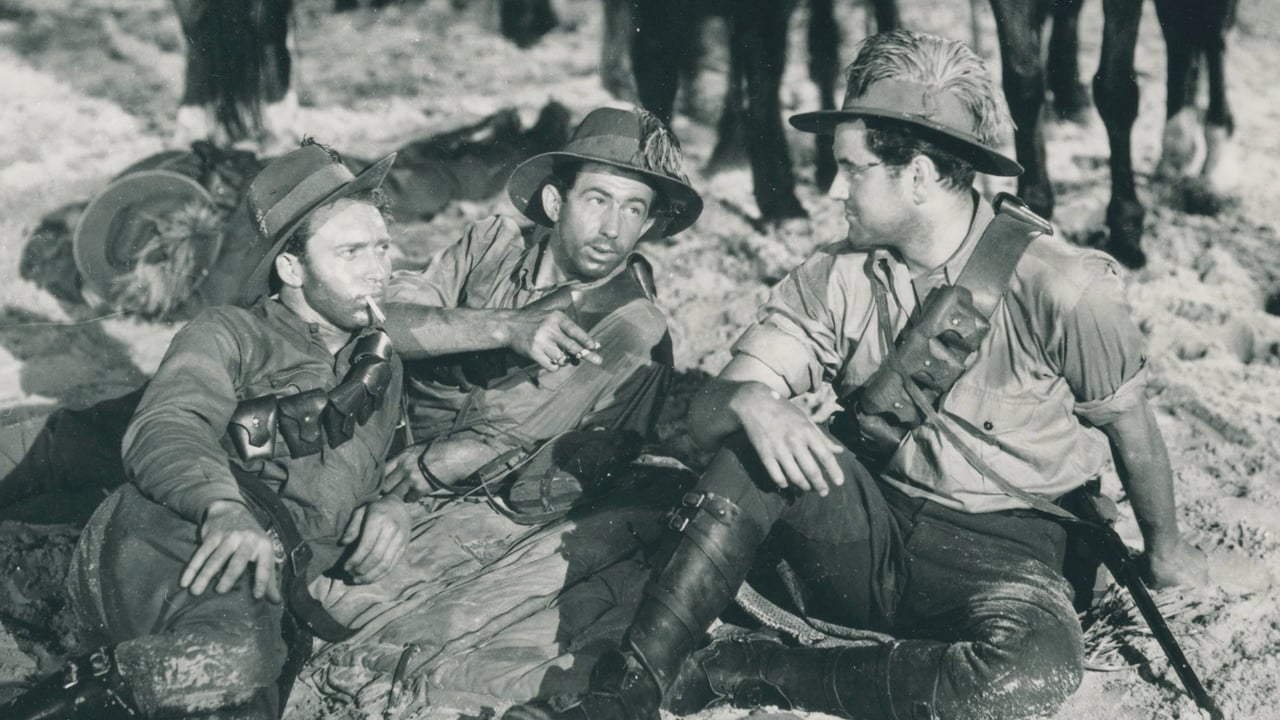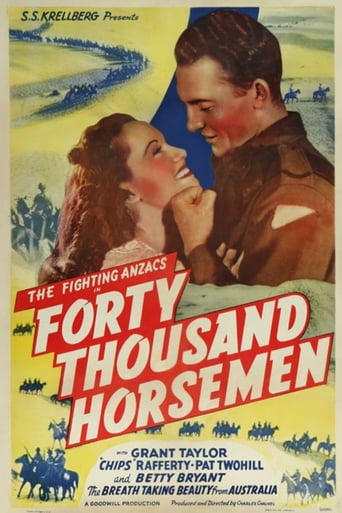

This movie was so-so. It had it's moments, but wasn't the greatest.
... View MoreIt is not only a funny movie, but it allows a great amount of joy for anyone who watches it.
... View MoreIt is encouraging that the film ends so strongly.Otherwise, it wouldn't have been a particularly memorable film
... View MoreStrong acting helps the film overcome an uncertain premise and create characters that hold our attention absolutely.
... View More40,000 Horseman tells the story of the Australian Light Horse cavalry which operated in the desert in Palestine and probably has to its credit the last successful cavalry charge in battle, though apparently according to other reviewers some who dispute it. I'm perfectly willing to give credit to Australia for this remarkable achievement.The story was filmed in 1940 when Australia had already entered World War II and troops were in the Sahara Desert while this movie was made. For propaganda necessity a hateful German had to be made the villain and Harvey Adams as Van Hausen certainly fills the bill there. To be sure Germans were in the desert, but the bulk of the fighting troops were the Aussies old foes from Gallipoli, the Turks. After all Palestine was part of their Ottoman Empire.The film was made by Charles Clauvel who's uncle Sir Harry Clauvel was the actual general in charge of the Australian Light Horse. Perhaps the younger Clauvel was undergoing an attack of modesty, but personally I'd have rather seen the story of the uncle and the battles done in a documentary style like The Longest Day.However several Australian acquaintances have told me that this film is regularly shown on Australian television on ANZAC day. Though the courage of the Aussies at Gallipoli gave the new continent nation a sense of national identity, this film does show them winning this one.It's the final cavalry charge at Beersheba which opened the way for General Allenby to take Jerusalem is the main feature of the film. Even given the superior production facilities in America at the time, no Hollywood film could have staged the battle better. It is one of the most exciting charges I've ever seen done from any country.I'm still not sure what the contrived romance between half French half Arab girl Betty Bryant and Aussie cavalryman Grant Taylor was doing here. Most of the time Betty is disguised as a boy. I'm thinking that Charles Clauvel might have seen Katharine Hepburn in Sylvia Scarlett and thought it was cute.As one of Taylor's mates is Chips Rafferty who was THE Australian cinema star for three decades. This was the film that got him his first real notice.Though the film probably could use a modern remake in the manner of Breaker Morant and Gallipoli without the wartime propaganda and unnecessary love story tossed in, 40,000 Horseman is an exciting piece of cinema detailing the story of one of the great events in Australian history. Maybe we'll get to see it on American television soon.
... View MoreOf course, since my dad passed away many years ago, I can't verify this. But I do remember him telling us kids that, as a member of the Australian Army Signals Corp, he and many of his fellow soldiers were recruited as horsemen to ride over the Kurnell sand hills as extras in this movie.Since this was filmed in 1941, Australia was already in the war. My Dad's was record shows his service in New Guinea as a Lieutenant in the signals corps. I also remember him telling me about how he was trained to ride a motor bike so, along with the horse riding his story about being an extra was probably something to do with preparing them for service overseas.If anybody that reads this is able to provide some verification that would be greatly appreciated.
... View MoreAlthough filmed 60 years ago I cannot think of a more thrilling realisation on film of a massed cavalry assault. The scene, which is sustained for several minutes, recreats the WWI charge of the Australian light horse on the Turkish-held town of Beersheeba, Palestine, in 1917. This is generally accepted as the last successful cavalry charge in military history (typically some eggheads - probably Brits - quibble on whether it was a true cavalry charge because the Australians were armed with bayonets rather than sabres; not that the distinction meant much to the unfortunates who ended up skewered on the end of them.)Also noteworthy for the presence of Chips Rafferty, in a typical role as a gangling Aussie bushmen, and who, in the days before Paul Hogan, represented the Australian male as he liked to imagine himself.
... View MoreThis movie shows the Aussie idea of "mateship" from a 1941 perspective. It is a part of our culture and as an Australian I'm proud to see it portrayed in this movie. Even though it does extend the stereotypical Aussie, you have to understand we may have change and grown a lot we still are a country who value friends and our relationships.
... View More